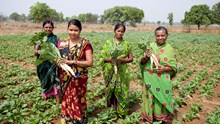
With the rising concern over post-harvest losses of perishable commodities such as fruits and vegetables, a significant innovation has emerged from the efforts of Dr. Ramakrishna A., Senior Scientist and Head at the Defence Food Research Laboratory (DFRL) within the Defence Research and Development Organisation (DRDO) of the Ministry of Defence, Government of India. Drawing on over three decades of experience in food Engineering, processing and packaging technologies, Ramakrishna developed ‘Krishi Kavach,’ an eco-friendly, power-free packaging solution designed to extend the shelf life of fresh produce, including flowers.
This innovation is rooted in his work at DRDO-DFRL, where he focused on creating resilient packaging solutions for the Armed Forces in extreme environments, now repurposed to benefit farmers and consumers alike.
To delve deeper into the inspiration behind this innovation and its real-world applications, Shivam Dwivedi from Krishi Jagran spoke with Dr. Ramakrishna A. During a detailed interview, he shared valuable insights into the development and potential of Krishi Kavach. Here’s an excerpt from the conversation:
1. Can you tell us what inspired the development of Krishi Kavach and how your background with DRDO-DFRL influenced this innovation?
The development of Krishi Kavach was inspired by my extensive experience in food Engineering, processing and packaging technologies, particularly during my nearly 34 years of service as Senior Scientist and Head at DRDO-DFRL. My work focused on developing innovative solutions that addressed the unique needs of the Armed Forces, as well as the civilian sector. This background gave me valuable insights into the challenges faced by soldiers, especially in extreme environments like high altitudes, deserts, and naval operations.
One of the major milestones of my career was the design and development of Indigenous Retort Processing Technology for Meals Ready to Eat (MRE), along with Retortable Flexible Standy Pouches that were specifically developed for the Armed Forces. These technologies were essential for food preservation and ease of transport, especially for soldiers stationed in remote and challenging locations.
In addition to this, I have been involved in the design of Agri-food processing equipment, which has spin-offs for civilian use, as well as space food packaging technology. A key innovation that stemmed from these efforts was the development of solar-powered fresh curd makers, rechargeable and reusable lightweight self-heating food warmers, and anti-freeze bags and bulk containers for storing fresh fruits and vegetables. These solutions were developed with the unique needs of soldiers in mind, including those stationed in icy high-altitude terrains, naval ship galleys, and for special operations for the Marcos.
The insights gained from these projects have significantly influenced the development of Krishi Kavach, a technology that blends my expertise in food packaging and preservation, particularly for the agricultural sector. This innovation aims to protect crops, improve shelf life, and enhance the logistics and supply chain, just as we did for military operations.
2. What specific challenges do Indian farmers face in post-harvest management, and how does Krishi Kavach address those issues?
I developed an interest and passion for creating breathable materials for vegetables to improve their shelf life, stemming from my PhD work on breathable materials. Later, after retirement, I took this as both a challenge and a passion to develop Krishi Kavach, a material that can enhance the shelf life of vegetables for up to 30 days without refrigeration, while also incorporating embedded antimicrobial and antifungal properties.
3. Could you explain the science behind the Krishi Kavach bags? How does the material composition help preserve produce for a longer time?
Since the patent is currently pending, I can simply share that the material used in Krishi Kavach bags is both biodegradable and bio-compostable. In the future, we will definitely have a consortium of people, including angel investors, for this type of technology that focuses on innovation and sustainability. For a common person or farmer, spending money on building infrastructure and machinery is quite difficult. However, with the support of angel investors, it will be in the best interest of our nation, our soldiers, farmers, and consumers. This will go a long way in making this technology not only available in Indian markets but also in international markets.
4. How customizable is Krishi Kavach for different stakeholders such as smallholders, exporters, or household users?
Yes, very rightly said. Krishi Kavach is customizable to meet the needs of various stakeholders, whether it's smallholders, exporters, or household users. The bags are designed to hold a range of produce, with capacities from 500 grams up to a maximum of 25 kg. Their size and shape can be customized to meet the specific requirements of different types of fruits or vegetables, taking into account factors such as the produce's type and its geometrical shape. This flexibility allows us to deliver tailored solutions without any issues, ensuring optimal packaging for each stakeholder's unique needs.
5. What role did institutions like Gandhi Krishi Vigyan Kendra (GKVK) and the Indian Institute of Horticulture Research play in verifying and supporting Krishi Kavach?
Yes, GKVKs provided their support. However, Indian Institute of Horticulture Research community, especially Dr. Dubey, which has given a very good impetus for this work. Krishi Kavach was also showcased during the Krishi Mela, where it received highly positive feedback from both farmers and consumers. The responses highlighted its utility, applicability, adaptability, and potential for enhancing bulk productivity.
6. You highlighted the importance of educating farmers about cost-effective innovations. How are you planning to roll out awareness and training programs for Krishi Kavach?
Yes, in fact, I am meeting with several cooperative societies, much like what Dr. Verghese Kurien did during the White Revolution. My aim is to establish cooperative societies as nodal points in rural villages. These centers will offer essential facilities for vegetable vendors, where produce can be cleaned, graded, hygienically packed, and then distributed to both domestic and international markets.
In addition, we will use these cooperative hubs to roll out awareness and training programs for Krishi Kavach. Farmers will receive hands-on training on the applicability and usability of cost-effective innovations, helping them adopt new techniques more effectively and sustainably.
7. Post-harvest loss is a critical issue in India. What kind of economic impact do you foresee if Krishi Kavach is adopted on a wide scale?
Very good question! In fact, if we look at the statistics, only about 20–30 % of our produce is consumed domestically, despite India being the second-largest producer of fruits and vegetables in the world. A large portion of this produce is wasted or goes unutilized due to various factors such as poor post-harvest technology, improper handling, inadequate packaging materials, lack of infrastructure, inefficient transportation, and over-reliance on refrigeration.
Refrigeration, while useful, has its drawbacks—it can cause a chilling effect on perishable vegetables, scientifically reducing their micronutrient content. The purpose of Krishi Kavach is to address these challenges by reducing the dependency on refrigeration and providing antimicrobial and antifungal protection to fruits and vegetables through innovative technology.
By significantly increasing the shelf life of horticultural crops and enabling greater value addition, Krishi Kavach will directly benefit farmers by boosting their income. This, in turn, can contribute positively to the country's GDP. My goal with Krishi Kavach is to help farmers increase their income, deliver hygienic and high-quality produce to consumers, and ensure nutrient-rich food reaches to our soldiers (Jawans) deployed in high-altitude areas.
(Compiled & written by Shivam Dwivedi)















Share your comments